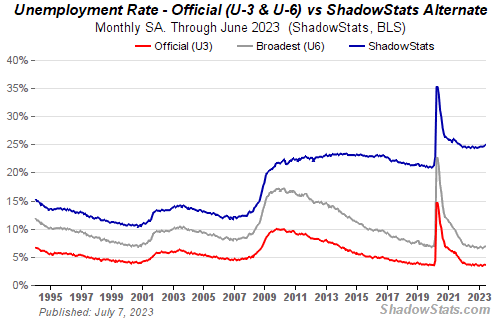There are a few statistics that you can look at to see actual human pain in the real economy. You can look at the recent stock market rally yet even a 50+ percent rally is unable to create jobs or stem the economic pain of those at the lower end of the economic spectrum. Looking at food stamp participation from the United States Department of Agriculture shows us a very disturbing picture. When we did a report on this in August of 2009 we had 34 million Americans on food stamps. In the span of one month, the number jumped by over a million.
The raw data shows us that a stunning 12 percent of our entire population is receiving some form of food stamp assistance. The program is now called Supplemental Nutrition Assistance Program but the theme is still the same. Let us look at some of the raw data:
Source: Sudden Debt
This is the highest percentage of Americans receiving food stamps since records started being kept back in 1969. The average person receiving assistance now receives $133 per month but even a number this low with such a high number of participants is costing the government $56 billion on an annualized basis.
Here are the top 5 states:
-1. Texas - 3.068 million participants
-2. California - 2.99
-3. New York - 2.57
-4. Florida - 1.77
-5. Illinois - 1.71
What is telling with the data above is that Texas has 24 million people while California has 37 million yet Texas has more people receiving food stamps. Florida and Illinois have nearly the same amount of participants although Florida has 18 million people while Illinois has 13 million people.
When we look at food stamp participation we see the real pain in the economy. I drive around many local areas in California. In many lower to middle class areas you will see department store traffic down to levels unseen in decades. Yet if you look at local dollar stores they are booming with traffic. People are asking about tent cities or soup lines but some of the “hidden” pain is mitigated by people simply buying at lower priced stores. After all, you can buy a loaf of bread, some sliced ham, a few cans of soup, and feed your family for a week. Although this is living on the margins you won’t be starving either but might explain why we haven’t seen a gigantic jump in tent cities or soup lines.
Yet there is a significant jump in traffic to local charities and shelters as you would expect in any deep recession. Those receiving food stamps will pump practically all the money back into the local economy. With $133 a month there isn’t much you can do. Yet it might be enough to provide a tiny buffer. I can only imagine how our country would look like right now if there were no food stamps or unemployment insurance. Can you imagine 35 million people out on the street in the United States of America?
Yet the stock market boosted by the U.S. Treasury and Federal Reserve is only helping the top bracket of our country. Most Americans have seen their hours cut, wages slashed, and are dealing with declining housing prices and a smaller stock portfolio. This is the reality on the ground. If we look at the real unemployment rate we are approaching Great Depression levels:
The headline unemployment rate is 9.7 percent. If we look at the government U-6 rate a broader and better indicator of the true employment situation we find that 16.8 percent of people are either unemployed or underemployed. A more broader measure already shows the unemployment rate at 20 percent. Some people have a hard time seeing this in action. Take a look at Detroit that has an unemployment rate of 28.9 percent. That is right, 28.9 percent of a city that once had 1.8 million people and was the hub of the automotive industry.
Even though the pundits and the Wall Street crowd are breathing happy in their custom made suits, the reality on the ground is very different. Those collecting food stamps are only growing. The unemployment rate is only moving up. It is hard for most Americans to except the “lagging indicator” argument when we are breaking records left and right. This is not your typical recession so why are we to expect that things will move out in a typical fashion? Ask those 35 million Americans if they feel the recession is over.


No comments:
Post a Comment